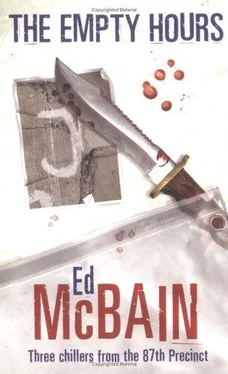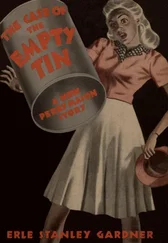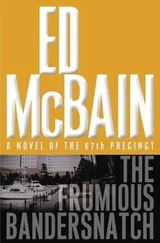“You were stabbing a rabbi!”
“You were killing a Jew!”
“I wasn’t any place near that —”
“Book him, Cotton. Suspicion of murder.”
“Suspicion of — I’m telling you I wasn’t—”
“Either shut up or start talking, you bastard,” Carella said. Finch shut up.
The girl came to see Meyer Meyer on Easter Sunday.
She had reddish-brown hair and brown eyes, and she wore a dress of bright persimmon with a sprig of flowers pinned to the left breast. She stood at the railing and none of the detectives in the squadroom even noticed the flowers; they were too busy speculating on the depth and texture of the girl’s rich curves.
The girl didn’t say a word. She didn’t have to. The effect was almost comic, akin to the cocktail-party scene where the voluptuous blonde takes out a cigarette and four hundred men are stampeded in the rush to light it. The first man to reach the slatted rail divider was Cotton Hawes, since he was single and unattached. The second man was Hal Willis, who was also single and a good red-blooded American boy. Meyer Meyer, an old married poop, contented himself with ogling the girl from behind his desk. The word shtik crossed Meyer’s mind, but he rapidly pushed the thought aside.
“Can I help you, miss?” Hawes and Willis asked simultaneously.
“I’d like to see Detective Meyer,” the girl said.
“Meyer?” Hawes asked, as if his manhood had been maligned.
“Meyer?” Willis repeated.
“Is he the man handling the murder of the rabbi?”
“Well we’re all sort of working on it,” Hawes said modestly.
“I’m Artie Finch’s girl friend,” the girl said. “I want to talk to Detective Meyer.”
Meyer rose from his desk with the air of a man who has been singled out from the stag line by the belle of the ball. Using his best radio announcer’s voice, and his best company manners, he said, “Yes, miss, I’m Detective Meyer.”
He held open the gate in the railing, all but executed a bow, and led the girl to his desk. Hawes and Kling watched as the girl sat and crossed her legs. Meyer moved a pad into place with all the aplomb of a General Motors executive.
“I’m sorry, miss,” he said. “What was your name?”
“Eleanor,” she said. “Eleanor Fay.”
“F-A-Y-E?” Meyer asked, writing.
“F-A-Y.”
“And you’re Arthur Finch’s fiancée? Is that right?”
“I’m his girl friend,” Eleanor corrected.
“You’re not engaged?”
“Not officially, no.” She smiled demurely, modestly and sweetly. Across the room, Cotton Hawes rolled his eyes toward the ceiling.
“What did you want to see me about, Miss Fay?” Meyer asked.
“I wanted to see you about Arthur. He’s innocent. He didn’t kill that man.”
“I see. What do you know about it, Miss Fay?”
“Well, I read in the paper that the rabbi was killed sometime between seven-thirty and nine. I think that’s right, isn’t it?”
“Approximately, yes.”
“Well, Arthur couldn’t have done it. I know where he was during that time.”
“And where was he?” Meyer asked.
He figured he knew just what the girl would say. He had heard the same words from an assortment of molls, mistresses, fiancées, girl friends and just plain acquaintances of men accused of everything from disorderly conduct to first-degree murder.
The girl would protest that Finch was with her during that time. After a bit of tooth-pulling, she would admit that — well — they were alone together. After a little more coaxing, the girl would reluctantly state, the reluctance adding credulity to her story, that — well — they were alone in intimate circumstances together. The alibi having been firmly established, she would then wait patiently for her man’s deliverance.
“And where was he?” Meyer asked, and waited patiently.
“From seven to eight,” Eleanor said, “he was with a man named Bret Loomis in a restaurant called The Gate, on Culver and South Third.”
“What?” Meyer was surprised.
“Yes. From there, Arthur went to see his sister in Riverhead. I can give you the address if you like. He got there at about eight-thirty and stayed a half-hour or so. Then he went straight home.”
“What time did he get home?”
“Ten o’clock.”
“He told us nine, nine-thirty.”
“He was mistaken. I know he got home at ten because he called me the minute he was in the house. It was ten o’clock.”
“I see. And he told you he’d just got home?”
“Yes.” Eleanor Fay nodded and uncrossed her legs. Willis, at the water cooler, did not miss the sudden revealing glimpse of nylon and thigh.
“Did he also tell you he’d spent all that time with Loomis first and then with his sister?”
“Yes, he did.”
“Then why didn’t he tell us?” Meyer asked.
“I don’t know why. Arthur is a person who respects family and friends. I suppose he didn’t want to involve them with the police.”
“That’s very considerate of him,” Meyer said drily, “especially since he’s being held on suspicion of murder. What’s his sister’s name?”
“Irene Granavan. Mrs. Carl Granavan.”
“And her address?”
“Nineteen-eleven Morris Road. In Riverhead.”
“Know where I can find this Bret Loomis?”
“He lives in a rooming house on Culver Avenue. The address is 3918. It’s near Fourth.”
“You came pretty well prepared, didn’t you, Miss Fay?” Meyer asked.
“If you don’t come prepared,” Eleanor answered, “why come at all?”
Bret Loomis was thirty-one years old, five feet six inches tall, bearded. When he admitted the detectives to the apartment, he was wearing a bulky black sweater and light-fitting dungarees. Standing next to Cotton Hawes, he looked like a little boy who had tried on a false beard in an attempt to get a laugh out of his father.
“Sorry to bother you, Mr. Loomis,’ Meyer said. “We know this is Easter, and —”
“Oh, yeah?” Loomis said. He seemed surprised. “Hey, that’s right, ain’t it? It’s Easter. I’ll be damned. Maybe I oughta go out and buy myself a pot of flowers.”
“You didn’t know it was Easter?” Hawes asked.
“Like, man, who ever reads the newspapers? Gloom, gloom! I’m fed up to here with it. Let’s have a beer, celebrate Easter. Okay?”
“Well, thanks,’ Meyer said, “but —”
“Come on, so it ain’t allowed. Who’s gonna know besides you, me and the bedpost? Three beers coming up.”
Meyer looked at Hawes and shrugged. Hawes shrugged back. Together, they watched Loomis as he went to the refrigerator in one corner of the room and took out three bottles of beer.
“Sit down,” he said. “You’ll have to drink from the bottle because I’m a little short of glasses. Sit down, sit down.”
The detectives glanced around the room, puzzled.
“Oh,” Loomis said, “you’d better sit on the floor. I’m a little short of chairs.”
The three men squatted around a low table which had obviously been made from a tree stump. Loomis put the bottles on the table top, lifted his own bottle, said “Cheers,” and took a long drag at it.
“What do you do for a living, Mr. Loomis?” Meyer asked.
“I live,” Loomis said.
“What?”
“I live for a living. That’s what I do.”
“I mean, how do you support yourself?”
“I get payment from my ex-wife.”
“You get payments?” Hawes asked.
“Yeah. She was so delighted to get rid of me that she made a settlement. A hundred bucks a week. That’s pretty good, isn’t it?”
Читать дальше












